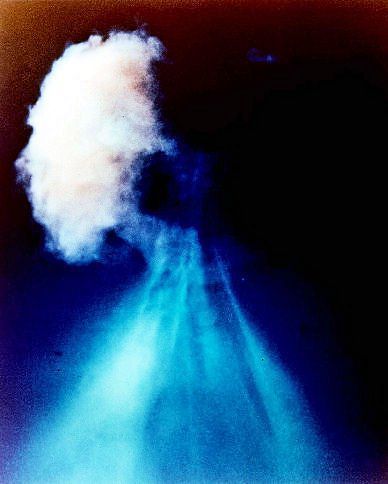Continued - Part 10
RAF Gan and Atomic Testing - 1958
Was Gan Affected by Nuclear Tests in 1958?
…well Yes ….and No
Nuclear Explosion Effects on HF Communications
As a VHF/DF radio operator I was based at R.A.F. Gan in the Maldives from January to November 1958. Gan had two HF/WT (Morse-code) circuits for connection to the outside world: an “Admin” circuit to RAF Katunayake (Negombo) Sri Lanka (Ceylon) for routine matters and an “Ops” circuit for communication with aircraft / ships etc on their way to and from the island.

R.A.F. Gan wireless operators working the “Admin” and “Operational” HF/WT Morse code circuits to Ceylon (Sri Lanka) in 1958.
Most times HF/WT comms worked well except for the occasion in late-August and early-September 1958 when contact with Ceylon was lost for a couple of days. This resulted from Operation Argus, the secret detonation by the Americans between 27th August 1958 and 6th September 1958 of three low yield nuclear warheads in the upper atmosphere over the South Atlantic to assess whether very high-altitude nuclear detonations could interfere with the magnetosphere and the Van Allen radiation belts and if such blasts would affect long-range high-frequency radio communications — in the event as far as R.A.F. Gan was concerned these detonations did so — and badly!
Background
Over the years from the first A-Bomb test in the United States in July 1945 well over 1,000 nuclear weapons were detonated mainly in the atmosphere.
After a slow build-up, the United States and Soviet Union together with the United Kingdom routinely held atmospheric nuclear tests; between 1953 and 1958, the United States, Soviet Union and the United Kingdom, held a total of 231 nuclear atmospheric tests. So testing was quite routine, but all was to change at the end of 1958 as the big powers decided that a temporary ban on nuclear testing would be imposed, but the USA wanted to test a couple of weapons before any test ban came into operation and so Operation Argus was born.
Operation Argus
Operation Argus was a series of three high-altitude nuclear tests conducted by the United States Atomic Energy Commission in the South Atlantic Ocean in August and September 1958. The results of Operation Argus proved the validity of the Christofilos theory.
This theory proposed that a radiation belt is created in the upper regions of the Earth’s atmosphere by high-altitude detonations. The radiation belt affects radio and radar transmissions, damages or destroys the arming and fusing mechanisms of Intercontinental Ballistic Missile warheads, and endangers crews of orbiting space vehicles that might enter the belt.
The tests, conducted in complete secrecy, were not announced until the following year. Low-yield devices were carried to an altitude of approximately 300 miles by rockets before being detonated.
More than 4,500 military personnel and civilian scientists participated in the test operation.
All three shots were launched by a specially modified Lockheed X-17A three-stage missile fired from the USS Norton Sound.

After effects of W-25 Nuclear warhead detonation
Operation Argus from Published Sources
The three Argus tests with their W-25 nuclear warheads were detonated at high-altitude. Argus 1 was launched on Wednesday, 27th August 1958 and detonated at a height of 124 miles (200 km), Argus II on Saturday, 30th August 1958 and detonated at a height of 159 miles (256 km) and finally Argus III on Saturday, 6th September 1958 detonated at a height of 335 miles (539 km) — perhaps the highest nuclear explosion ever.
A total of nine (9) United States Navy ships participated in Operation Argus. Each ship left port separately with no knowledge of the others. Collectively known as Task Force 88 (TF-88), these ships came together for the first time at the Operation Argus South Atlantic test location in August of 1958. The missile launching ship for Operation Argus was the USS Norton Sound. Approximately 4,500 individuals participated in Operation Argus with the entire effort classified as Secret. The secret was well kept as it was only in the following year (1959) that the New York Times broke the story of this closely guarded secret test series.

The three Argus test warheads were launched in specially modified Lockheed X-17A three-stage missiles fired from the USS Norton Sound. The W-25 nuclear warhead was 27-inches long, 17-inches in diameter and weighed 220lbs (100kg). It is contained in the bulge at the top of the X-17A missile shown here ready for launching.
Problems at Gan
The absence of communications at RAF Gan caused a major upset as we didn’t know what was going on and with no reliable communications to the outside world we were totally in the dark! Shortly afterwards communications with the outside world returned to normal and as far as I can recall there was never an “official” explanation as to what had caused the communications blackout.
At the time I was one of the two operators who operated the RAF Gan amateur radio station VS9MA and communications on the amateur radio bands in the southern hemisphere were badly affected too. When things returned to normal there was much speculation by amateur radio operators on the HAM bands as to the cause of this major disruption, most theories centring on unusual solar activity being the culprit as abnormal solar activity is a known and regular disrupter of high-frequency radio communications.
With no other explanation, this theory afforded a plausible explanation of the event until it was finally reported a year later that the detonation of nuclear warheads in space was the real cause of the radio black-out.